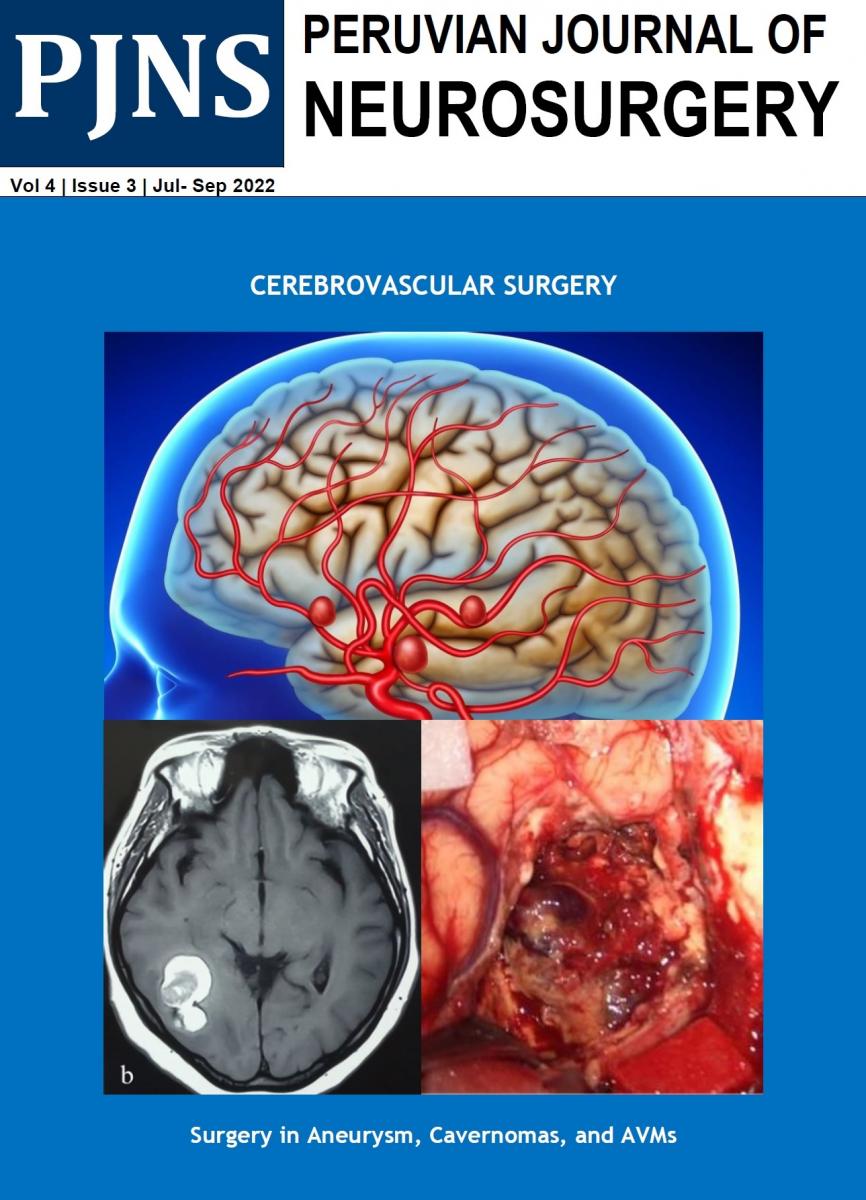GABRIEL PONCE M, OSMAR ORDINOLA C, DANTE VALER G., GIANCARLO SAAL Z., JESÚS FLORES Q., RODOLFO RODRÍGUEZ V.
Tipo:
Original Article
ABSTRACT (English):
Objective: The goal of this study is to present the outcomes of endovascular treatment performed on a group of patients diagnosed with ruptured aneurysms in the anterior communicating artery. The effectiveness of the treatment will be assessed based on the degree of packing observed in both immediate and subsequent angiography control.
Methods: An observational, retrospective, and descriptive study was conducted at the Guillermo Almenara Hospital to analyze the treatment outcomes of patients with ruptured anterior communicating artery aneurysms, who were solely treated through embolization with coils (without stent or balloon) in the year 2021 and 2022. The degree of packing of the aneurysms was measured and analyzed using the AngioCalc program, while data analysis was performed using Excel.
Results: Three patients with ACom aneurysm were successfully treated using only coils for embolization. Among them, two patients had a Fisher IV subarachnoid hemorrhage (SAH) while one patient had a Fisher III SAH. The volume of the aneurysm was 12.78 mm3 for patient A, 51.65 mm3 for patient B, and 34.06 mm3 for patient C. The degree of packing of the aneurysm was calculated using a formula and found to be 23.79%, 28.7%, and 34.06% for patients A, B, and C respectively. These values were all greater than 24%. The immediate angiography results were classified as RR II for patients A and B, and RR IIIA for patient C. Subsequent angiographic control results were classified as RR IIIA for patient A, RR II for patient B, and RR IIIB for patient C. All patients had a favorable outcome.
Conclusions: The degree of coil packing affects the evolution of an embolized aneurysm, therefore serial angiographic monitoring is necessary to detect recurrence and perform additional endovascular treatment if needed.
Keywords: Aneurysm, Ruptured, Subarachnoid Hemorrhage, Angiography, Embolization, Therapeutic. (Source: MeSH NLM)
ABSTRACT (Spanish):
Objetivo: Describir los resultados del tratamiento endovascular en una serie de pacientes tratados de aneurismas rotos de la arteria comunicante anterior y evaluar la efectividad de la técnica en base al grado de empaquetamiento en una angiografía de control inmediato y en una angiografía de control posterior.
Métodos: Se realizó un estudio observacional, retrospectivo, descriptivo en el Hospital Guillermo Almenara de los pacientes con aneurisma roto de arteria comunicante anterior tratados sólo mediante embolización con coils (sin stent o balón) en el 2021 y 2022 y se midió el grado de empaquetamiento de estos. El análisis de los datos se hizo con el programa Excel y el grado de empaquetamiento se hizo con el programa AngioCalc.
Resultados: Se encontró a 3 pacientes con aneurisma de ACom embolizados sólo con coils. 2 pacientes tuvieron una hemorragia subaracnoidea (HSA) Fisher IV y 1 paciente tuvo HSA Fisher III. El volumen del aneurisma fue de 12.78 mm3 (paciente A), 51.65 mm3 (paciente B) y 34.06 mm3 (paciente C). El grado de empaquetamiento del aneurisma según fórmula fue de 23.79%, 28.7 y 34.06% en los pacientes A, B y C respectivamente (superior a 24%). La clasificación de Raymond Roy (RR) en angiografía inmediata fue: RR II (pacientes A y B), RR IIIA (paciente C); y en el control angiográfico posterior fue: RR IIIA (paciente A), RR II (paciente B) y RR IIIB (paciente C). Todos los pacientes tuvieron una evolución favorable.
Conclusiones: La evolución de un aneurisma embolizado con coils depende de diversas variables siendo una de ellas el grado de empaquetamiento. Se requiere de un control angiográfico seriado para poder detectar una recurrencia y realizar un el tratamiento endovascular complementario de forma oportuna.
Palabras Clave: Aneurisma Roto, Hemorragia Subaracnoidea, Angiografía, Embolización Terapéutica. (Fuente: DeCS Bireme)


